There is a question of how to prove Ceva's theorem using vectors. I looked at the reference answer and I am so confused about it. Here are the question and a part of the reference answer(The following text is translated from a book written in Japanese. I'm sorry if it's weird to read):
Question:
Complete the following proof. For a triangle ABC, X, Y, and Z are three points on BC, CA, AB, respectively. The segments AX, BY and CZ intersect at one point. The necessary and sufficient conditions of that is $\displaystyle \frac{BX}{XC} \times \frac{CY}{YA} \times \frac{AZ}{ZB} \ =\ 1$
A part of the reference answer:

Suppose that the position vectors of A, B and C are a, b, c.
$\displaystyle \overrightarrow{BX} =l\overrightarrow{XC} ,\ \overrightarrow{CY} =m\overrightarrow{YA} ,\ \overrightarrow{AZ} =n\overrightarrow{ZB}$
so the position vectors of X, Y, and Z are $\displaystyle \frac{b+lc}{l+1} ,\ \frac{c+ma}{m+1} ,\frac{a+nb}{n+1}$(I can't get it)
Please help:
The definition of position vector from wiki:
In geometry, a position or position vector, also known as location
vector or radius vector, is a Euclidean vector that represents the
position of a point P in space in relation to an arbitrary reference
origin O.
So where is the origin O in this question and how to understand the position vectors of X, Y, and Z

Best Answer
Explicitly: Let $O$ be an arbitrary reference origin, and $a,b,c$ be the corresponding position vectors of $A,B,C,$ respectively.
Then the position vector of $X$ is \begin{align}\vec{OX}&=\vec{OC}+\vec{CX} \\&=\vec{OC}+\frac{1}{l+1}\vec{CB} \\&=\vec{OC}+\frac{1}{l+1}\left(\vec{OB}-\vec{OC}\right) \\&=\frac{l\vec{OC}+\vec{OB}}{l+1} \\&=\frac{b+lc}{l+1}, \end{align} as required.